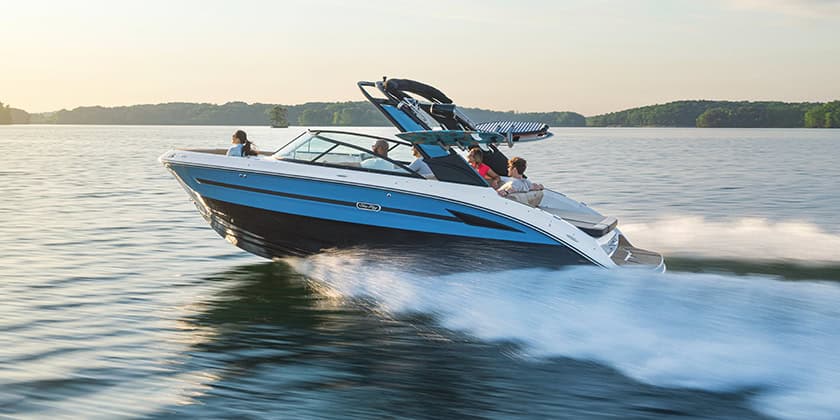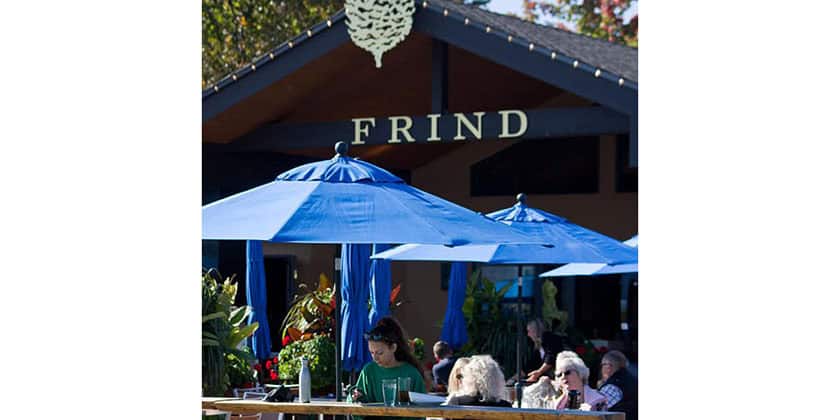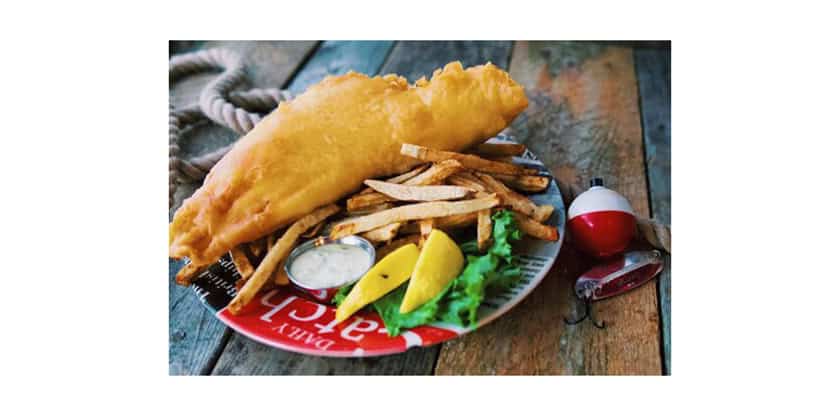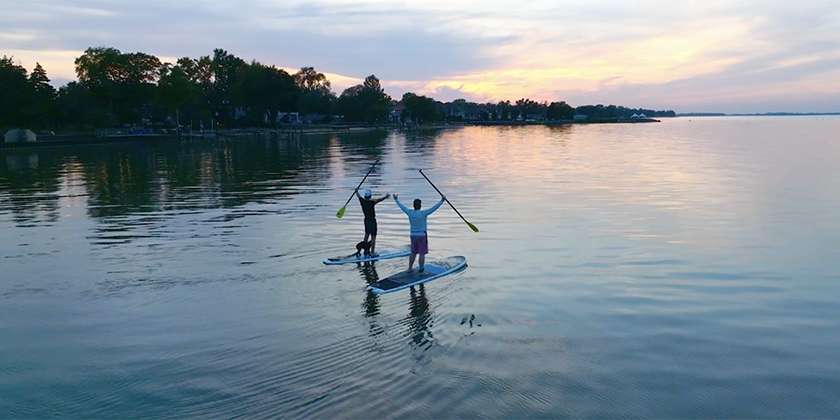Corbin 39
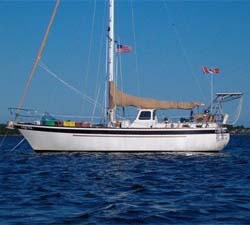 By Paul Howard
By Paul Howard
“I was looking for a boat that could take me safely and comfortably around the world,” writes Marius Corbin, the founder of Corbin les Bateaux Inc. in 1977. At the end of an extensive search for a serious long-distance cruiser, Corbin chose a design by Robert Dufour of Dufour Yacht Design in Montreal. Dufour’s Harmonie – the prototype of the Corbin 39 – had a canoe stern, a long, shallow fin keel with a vertical, skegg-supported rudder. Corbin and Dufour agreed to modify Harmonie by adding higher topsides and a flush deck to increase the boat’s interior volume. These modifications gave birth to the Corbin 39, and shortly after in 1979 Corbin les Bateaux pulled their first boat from its mould. Corbin elected to use encapsulated ballast in his hulls – a common boat-building method, but one that can make a hull vulnerable in a serious grounding as there is no external ballast to absorb the shock of a big bump. Corbin boasts, however, that he has added eight layers of fiberglass between the ballast and the hull so that his boat will not sink if the fiberglass keel is damaged.
Overall, the laminate schedule of the Corbin (the recipe for how much glass to use in the hull) is impressive, calling for 11 layers of fiberglass mat or roving, in addition to a 16 mm Airex core. The deck is a wide and flat expanse with a non-skid gel coat surface and a 3/4 inch marine-grade mahogany core. There are no interior hull mouldings, but the plywood bulkheads are cushioned with foam core before they are glassed in. There were no changes to the construction of the hull during the production run of the aft- and centre-cockpit models. Hulls number 1 through #129 are recognizable by a small cockpit footwell, narrow side decks along the cockpit, and a low pilothouse trunk.
A fire at the Corbin factory at Chateauguay, Que. in late ’82 destroyed the Corbin’s deck moulds, and provided the impetus to redesign the aft-cockpit version to create a larger cockpit and a higher pilothouse trunk. At the same time, Corbin added a pilothouse to the initial centre-cockpit version. Both of these revised versions sported a taller rig, with the mast step moved two-and-a-half feet further forward. Other modifications included leading the forestay to the end of a three-foot bowsprit with dual anchor rollers. It appears that the repositioning of the mast step was undertaken to solve weather helm problems in the early Corbins. Everett Bastet of E.B. Spars Inc. in Hudson, Que. provided most of the masts, rigging and related gear on the Corbin boats. He says the early rig was either a 46-foot single-spreader mast, or a 51-foot double-spreader section. Subsequent versions had double-spreader 49-foot masts, yet all the Corbin sticks were deck-stepped and stayed with 5/16 in. diameter, 9 by 32 wire. It is interesting to note that the ketch rig had its main mast stepped in the same position as the mast step on the cutter rig.
Corbins were built in various shops in Chateauguay, Napierville and St. Paul de l’Ile aux Noix, Que., with the final hull (number 199) built in 1990. The majority of these boats were finished by amateur builders from one of four stages of completion: a hull and deck; hull and deck including six structural bulkheads and ballast; motor-away and sail-away. In the motor-away package, the engine and tanks were installed but the interior was otherwise empty. The most complete sail away package included engine, tanks, mast and sails, but no interior. About 15 boats were factory-finished to a high standard to serve as demo boats for boat shows. All had custom interiors, and no two were alike. The early pilothouse version had a conventional straight-shaft engine installation with either a Volkswagen Pathfinder or Westerbeke 33 hp diesel engine under the galley sink, although some Corbins were built with the Bukh 36 hp saildrive. Centre-cockpit versions, however, placed the engine in its own room under the cockpit sole. A later aft-cockpit model had a vee-drive connected to the Westerbeke or a Perkins 4-108 diesel. A mainsheet traveller is mounted on the bridge deck of the earlier boats, but the cockpit is cramped by a boom gallows and a hydraulic steering pedestal – a cosy setting for four close friends. In later aft-cockpit boats, the cockpit was widened and lengthened, and the mainsheet traveller was moved to the pilothouse roof to make more room for lounging in the cockpit. All the Corbins have enormous deck anchor lockers – perhaps the largest I have seen – with two hatches in the foredeck that will comfortably hold all the anchors, chain, hoses and shore-power cables any long-distance cruiser will desire. This excellent storage in the bow partially makes up for the Corbin’s tiny cockpit lockers. The interior of the aft-cockpit model begins under a large pilothouse. Inside is a centre-line steering console, a nav station, either a quarter berth or hanging locker to port, and settee to starboard. There are two steps down to the main salon under the flush deck, with a large galley to port and a fridge/freezer to starboard. The dinette sits in front of the fridge with a settee or pedestal chairs on the opposite side. The head and a hanging locker separate the main salon from the forward vee-berth. Headroom is generous throughout and there are fixed ports in the topsides of the hull. Eight opening deck hatches provide lots of light and ventilation in the interior. The aft-cabin model features a double berth and choice of either an aft head, or increased stowage and a work area in the engine room.
If you are a Corbin fan and are considering a custom boat, you will want to get in touch with Giles Bastien, a former employee of Marius Corbin who now owns the Corbin moulds. He has plans to build boats to order, but has no commitments to date. Bastien also has a couple of unfinished hull-and-deck kits that he intends to sell to home-builders or complete himself for owners.
As a general rule, boats that are built by amateurs fetch lower prices, although final finish is certainly the determining factor to a Corbin’s value. Incomplete hull and deck kits start at around $35,000. Rough and poorly-finished boats sell for $75,000. Factory completed vessels start at $150,000. Reg and Patricia Watts were looking for a boat to retire on that could take them anywhere on the planet without concern for structural integrity. This Mississauga, Ont. couple also wanted a boat with moderate draft that would be both comfortable to live aboard and easy to handle. In the early spring of 1995, the Watts settled on an early Corbin, Dora Rose, built in 1980. (The boat’s first owner, Rupert Cheeseman, finished this boat in a cherry wood interior to a decent standard, and took the boat from Lake Ontario to the Caribbean three times.) “When you buy a boat for a specific purpose,” Watts observes, “you worry about making too many compromises, but this didn’t apply to the Corbin. In all, we are really pleased with the boat. We did worry about the two of us being able to handle a boat of this size, but we find her manageable because of her docile characteristics.” Patricia Watts adds, “Dora Rose gives us confidence whatever the weather. In fact, we are dry, comfortable, and are often out sailing when others stay at the dock.” Terry Forsbrey is the second owner of Stella, a later-model kit-boat that is one of the best looking and best-equipped Corbins I have seen. Before heading down to Chesapeake Bay, Forsbrey had Wiggers Custom Yachts in Bowmanville, Ont. fair the hull and paint the topsides – a job that included spraying on, then sanding back, five coats of epoxy primer before the topcoat went on. This completely removed the fibreglass roving show-through that affects some of the Corbin hulls. To be fair, however, the glass work on these boats is otherwise very good. Forsbrey recalls, “One day when I was down at Wiggers, I met with [CY columnist] Steve Killing. When I asked him about the weather helm I was experiencing, Killing made a quick sketch to extend the forward edge of my skeg by seven inches. Wiggers made the modifications and they have made a big difference to Stella’s performance.” Forsbrey also added a high roach, fully battened mainsail, and removed the suggested amount of rake from the rig. With this turbo-charged set-up he won the Oshawa Clipper Race, a double-handed, 100-mile race across Lake Ontario. “These boats sail well in light airs,” Foresbrey adds, “and I find I can ghost along and pass many other more performance-oriented boats. She is not sharp to windward in light winds, but get her moving and she carries her way.” Marius Corbin talks proudly of the global fleet of his boats. “We get postcards from all over the world – Japan, Australia, South Africa, you name it – from owners who love the boats for their liveability and seakindly manner.” What better recommendation is there for a strong and seaworthy vessel that is ready for the world’s oceans? Looking for a contact?
Originally published in Canadian Yachting’s Winter 1996 issue.
Specifications:
LOA – 38 ft 6 in.
LWL – 31 ft 11 in.
Beam – 12 ft
Draft – 5 ft 6 in.
Displacement – 22,800 lbs.










